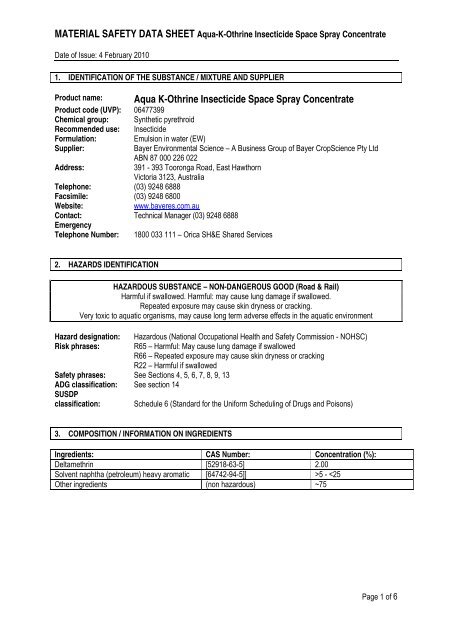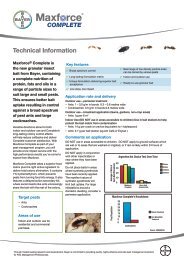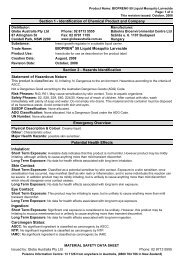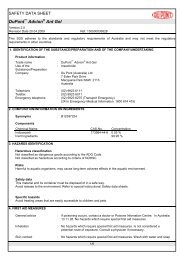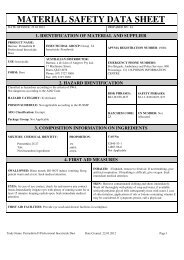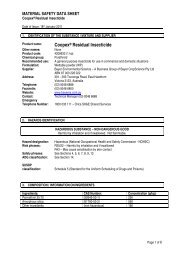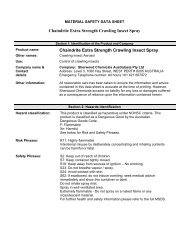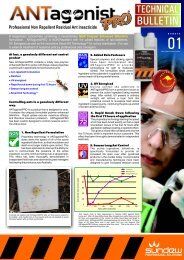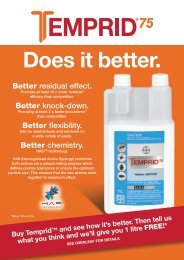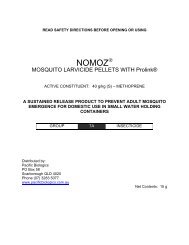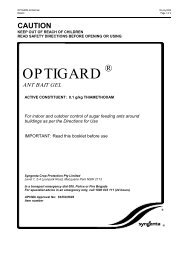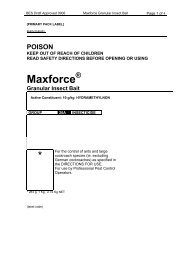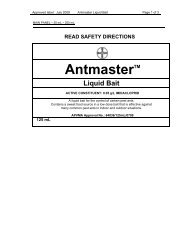Aqua-K-Othrine MSDS - Agserv
Aqua-K-Othrine MSDS - Agserv
Aqua-K-Othrine MSDS - Agserv
You also want an ePaper? Increase the reach of your titles
YUMPU automatically turns print PDFs into web optimized ePapers that Google loves.
MATERIAL SAFETY DATA SHEET <strong>Aqua</strong>-K-<strong>Othrine</strong> Insecticide Space Spray Concentrate<br />
Date of Issue: 4 February 2010<br />
1. IDENTIFICATION OF THE SUBSTANCE / MIXTURE AND SUPPLIER<br />
<strong>Aqua</strong> K-<strong>Othrine</strong> Insecticide Space Spray Concentrate<br />
Product name:<br />
Product code (UVP): 06477399<br />
Chemical group: Synthetic pyrethroid<br />
Recommended use: Insecticide<br />
Formulation:<br />
Emulsion in water (EW)<br />
Supplier:<br />
Bayer Environmental Science – A Business Group of Bayer CropScience Pty Ltd<br />
ABN 87 000 226 022<br />
Address:<br />
391 - 393 Tooronga Road, East Hawthorn<br />
Victoria 3123, Australia<br />
Telephone: (03) 9248 6888<br />
Facsimile: (03) 9248 6800<br />
Website:<br />
www.bayeres.com.au<br />
Contact: Technical Manager (03) 9248 6888<br />
Emergency<br />
Telephone Number: 1800 033 111 – Orica SH&E Shared Services<br />
2. HAZARDS IDENTIFICATION<br />
HAZARDOUS SUBSTANCE – NON-DANGEROUS GOOD (Road & Rail)<br />
Harmful if swallowed. Harmful: may cause lung damage if swallowed.<br />
Repeated exposure may cause skin dryness or cracking.<br />
Very toxic to aquatic organisms, may cause long term adverse effects in the aquatic environment<br />
Hazard designation:<br />
Risk phrases:<br />
Hazardous (National Occupational Health and Safety Commission - NOHSC)<br />
R65 – Harmful: May cause lung damage if swallowed<br />
R66 – Repeated exposure may cause skin dryness or cracking<br />
R22 – Harmful if swallowed<br />
Safety phrases: See Sections 4, 5, 6, 7, 8, 9, 13<br />
ADG classification: See section 14<br />
SUSDP<br />
classification:<br />
Schedule 6 (Standard for the Uniform Scheduling of Drugs and Poisons)<br />
3. COMPOSITION / INFORMATION ON INGREDIENTS<br />
Ingredients: CAS Number: Concentration (%):<br />
Deltamethrin [52918-63-5] 2.00<br />
Solvent naphtha (petroleum) heavy aromatic [64742-94-5]] >5 -
MATERIAL SAFETY DATA SHEET <strong>Aqua</strong>-K-<strong>Othrine</strong> Insecticide Space Spray Concentrate<br />
Date of Issue: 4 February 2010<br />
4. FIRST AID MEASURES<br />
If poisoning occurs, immediately contact a doctor or Poisons Information Centre (telephone 13 11 26), and<br />
follow the advice given. Show this Material Safety Data Sheet to a doctor.<br />
Inhalation:<br />
Skin contact:<br />
Eye contact:<br />
Ingestion:<br />
First Aid Facilities:<br />
Symptoms:<br />
If inhaled, remove to fresh air and keep at rest. If symptoms persist seek medical advice.<br />
Carefully remove contaminated clothing and footwear. Wash affected areas with soap and<br />
plenty of water. After skin contact: apply vitamin E cream, toilet milks or local anaesthetic<br />
creams to reduce irritation if it occurs. If symptoms persist seek medical advice.<br />
Rinse immediately with plenty of water, also under the eyelids, for at least 15 minutes.<br />
Remove contact lenses (if relevant) after the first 5 minutes, then continue rinsing eye.<br />
Seek medical advice if irritation develops and persists.<br />
Rinse out mouth and give water in small sips to drink. Rinse mouth, ingest activated<br />
charcoal. Do not induce vomiting. If symptoms persist seek medical advice.<br />
Induce vomiting only, if: 1.Patient is fully conscious, 2. Medical aid is not readily available,<br />
3. A significant amount (more than a mouthful) has been ingested and 4. time since<br />
ingestion is less than 1 hour. (Vomit should not get into the respiratory tract).<br />
Ensure eye wash and safety shower are available.<br />
Local: Skin and eye paraesthesia which may be severe. Usually transient with resolution<br />
within 24 hours, eye and mucous membrane irritation, cough.<br />
Systemic: Discomfort in the chest, bronchial hyper-secretion, pulmonary oedema,<br />
tachycardia, low blood pressure, palpitation, vomiting, diarrhoea, abdominal pain, nausea,<br />
salivation, dizziness, blurred vision, headache, apathy, anorexia, somnolence, coma,<br />
spasm, convulsions, tremors, ataxia, muscular fasciculation.<br />
This product contains a pyrethroid and must NOT be confused with organophosphate<br />
compounds.<br />
Treatment:<br />
Local treatment: Treat symptoms. Skin contacted by deltamethrin must be carefully<br />
cleaned with cleansing milk. Symptoms can be partially alleviated by the application of a<br />
vitamin E or moisturising cream or anaesthetic ointment. For eyes, instil local anaesthetic<br />
drops e.g. 1% amethocaine hydrochloride eye drops. Give analgesics as necessary.<br />
Systemic treatment:<br />
Endotracheal intubation and gastric lavage, followed by administration of charcoal.<br />
Monitoring of respiratory and cardiac functions.<br />
ECG – monitoring (Electrocardiogram)<br />
Check for pulmonary oedema in event of inhalation.<br />
Keep airway clear, administer artificial respiration if necessary.<br />
Anticonvulsant therapy with diazepam. For adults 5 – 10 mg i.v. as necessary until fully<br />
sedated; for children 2.5 mg i.v.<br />
No antidote known. Treat symptoms. Recovery should be spontaneous.<br />
Contraindication – adrenergic compounds, atropine.<br />
DO NOT confuse with anticholinesterase compounds.<br />
Page 2 of 6
MATERIAL SAFETY DATA SHEET <strong>Aqua</strong>-K-<strong>Othrine</strong> Insecticide Space Spray Concentrate<br />
Date of Issue: 4 February 2010<br />
5. FIRE FIGHTING MEASURES<br />
Extinguishing media:<br />
Hazards from<br />
combustion<br />
products:<br />
Precautions for fire<br />
fighters:<br />
Water spray, alcohol resistant foam, carbon dioxide or dry chemical.<br />
High volume water jet is not recommended.<br />
Dangerous gases are evolved in the event of a fire.<br />
Fire fighters should wear full protective gear, including self-contained breathing apparatus<br />
(AS/NZS 1716), as toxic and irritating decomposition products may be produced in a fire. If<br />
it can be done safely, remove intact containers from the fire. Otherwise, use water spray to<br />
cool them. Bund area to prevent contamination of water sources. Dispose of fire control<br />
extinguishing agent and spillage later in a safe manner. Do not release contaminated<br />
water into the environment.<br />
6. ACCIDENTAL RELEASE MEASURES<br />
Avoid contact with spilled material or contaminated surfaces. When dealing with the spillage do not eat, drink or<br />
smoke and wear personal protective clothing and equipment as detailed in ‘Personal Protection’ section. Keep<br />
people and animals away. Prevent spillage from entering drains, sewers or watercourses. Contain/absorb spillage in<br />
sand/earth or other suitable inert material. Transfer collected material to sealable containers. Seal and label<br />
containers ready for disposal. Deal with all spillages immediately. If contamination of drains, streams, watercourses,<br />
etc. is unavoidable, warn the local water authority.<br />
7. HANDLING AND STORAGE<br />
Handling:<br />
Storage:<br />
No specific precautions required when handling unopened packs/containers, follow<br />
relevant manual handling advice.<br />
Keep out of reach of children. Store in original container in a cool, dry, well-ventilated area.<br />
Keep away from food, drink and animal feedstuffs. Keep out of direct sunlight and protect<br />
from freezing. Keep away from heat and sources of ignition.<br />
Storage temperature should ideally lie between 0 and 30°C, however storage for two<br />
weeks at 54°C has shown no adverse effects regarding product safety or stability.<br />
Suitable storage containers:<br />
Co-extruded containers with internal barrier layer made of ethylene vinyl alcohol copolymer<br />
(EVOH).<br />
Co-extruded containers with an internal barrier layer made of polyamide (PA).<br />
Fluorinated HDPE.<br />
Page 3 of 6
MATERIAL SAFETY DATA SHEET <strong>Aqua</strong>-K-<strong>Othrine</strong> Insecticide Space Spray Concentrate<br />
Date of Issue: 4 February 2010<br />
8. EXPOSURE CONTROLS / PERSONAL PROTECTION<br />
Exposure standards:<br />
Engineering controls:<br />
Personal Protective<br />
Equipment:<br />
No exposure standard has been assigned by Safe Work Australia. Bayer recommends an<br />
Occupational Exposure Standard for deltamethrin of 0.28 mg/m³.<br />
Control process conditions to avoid contact.<br />
In normal use and handling refer to product label.<br />
In all other cases the following recommendations apply:<br />
Respiratory protection: No personal respiratory protective equipment normally required.<br />
Hand protection: Wear CE marked (or equivalent) nitrile rubber gloves (minimum<br />
thickness 0.4 mm). Wash when contaminated. Dispose of when contaminated inside,<br />
when perforated or when contamination outside cannot be removed. Wash hands before<br />
eating, drinking, smoking or using the toilet.<br />
Eye protection: Wear goggles.<br />
Skin and body protection: Wear polyester/cotton overalls underneath chemical protection<br />
suit if possible.<br />
9. PHYSICAL AND CHEMICAL PROPERTIES<br />
Appearance:<br />
Odour:<br />
Vapour pressure:<br />
Vapour density:<br />
Boiling point:<br />
Solubility:<br />
Density:<br />
pH:<br />
Flash Point:<br />
Flammability<br />
(explosive) limits:<br />
Ignition temperature:<br />
Octanol/water<br />
partition coefficient:<br />
Formulation:<br />
Opaque white liquid<br />
Strong characteristic hydrocarbon<br />
Not available<br />
1.00 (relates to the solvent naptha petroleum)<br />
Not available<br />
Forms an emulsion<br />
1.002 g/cm 3 at 20 o C<br />
3.5 – 5 at 100% (20°C)<br />
Not applicable<br />
Not applicable<br />
>450 °C (relates to the solvent naptha petroleum)<br />
LogP ow = 4.6 (25 °C) – deltamethrin<br />
Emulsion in water (EW)<br />
10. STABILITY AND REACTIVITY<br />
Chemical stability:<br />
Conditions to avoid:<br />
Hazardous reactions:<br />
Stable under normal conditions of use.<br />
Avoid extremes of temperature and direct sunlight.<br />
No hazardous reactions when stored and handled according to prescribed instructions<br />
(refer to product label).<br />
Page 4 of 6
MATERIAL SAFETY DATA SHEET <strong>Aqua</strong>-K-<strong>Othrine</strong> Insecticide Space Spray Concentrate<br />
Date of Issue: 4 February 2010<br />
11. TOXICOLOGICAL INFORMATION<br />
Acute oral toxicity:<br />
Acute dermal toxicity:<br />
LD 50 rat: 304 mg/kg<br />
LD 50 rat: > 5000 mg/kg<br />
Cutaneous sensations may occur such as burning or stinging on the face and<br />
mucosae. However these sensations cause no lesions and are of a transitory<br />
nature (max 24 hours).<br />
Acute inhalation toxicity:<br />
Skin irritation:<br />
Eye irritation:<br />
Sensitisation:<br />
LC 50 (4 h) rat: > 5.8 mg/L<br />
When inhaled in high concentration, the solvent vapours cause a narcotic effect.<br />
Slightly irritating (rabbit). Does not require labelling.<br />
Slightly irritating (rabbit). Does not require labelling.<br />
Non-sensitising (guinea pig)<br />
OECD Test Guideline 406, Buehler test<br />
Other information:<br />
Deltamethrin is not mutagenic, carcinogenic or teratogenic.<br />
12. ECOLOGICAL INFORMATION<br />
Fish toxicity:<br />
Daphnia toxicity:<br />
Toxicity to algae:<br />
Bird toxicity:<br />
Bee toxicity:<br />
Environmental fate,<br />
persistence and<br />
degradation:<br />
Deltamethrin: LC 50 : 0.001 – 0.01 mg/L (96 h) fish.<br />
Deltamethrin: LC 50 (48h): 3.5 μg/L<br />
Deltamethrin: EC 50 (96h): >9.1mg/L<br />
Deltamethrin: LD 50 : > 5,000 mg/kg duck<br />
Deltamethrin: LD 50 : > 10,000 mg/kg quail<br />
Deltamethrin found to be highly toxic in lab studies but considered less toxic under natural<br />
conditions.<br />
Deltamethrin is not persistent in the environment. It is destroyed by soil micro-organisms<br />
and does not leave residues in the environment or build up in the food chain.<br />
Page 5 of 6
MATERIAL SAFETY DATA SHEET <strong>Aqua</strong>-K-<strong>Othrine</strong> Insecticide Space Spray Concentrate<br />
Date of Issue: 4 February 2010<br />
13. DISPOSAL CONSIDERATIONS<br />
Triple or preferably pressure rinse containers before disposal. Add rinsings to treatment mixture. Do not dispose of<br />
undiluted chemicals on site. If recycling, replace cap and return clean containers to recycler or designated collection<br />
point. If not recycling, break, crush, or puncture and bury empty containers in a local authority landfill. If no landfill is<br />
available, bury the containers below 500 mm in a disposal pit specifically marked and set up for this purpose clear of<br />
waterways, desirable vegetation and tree roots. Empty containers and product should not be burnt.<br />
14. TRANSPORT INFORMATION<br />
IMDG<br />
UN number: UN 3082<br />
Description of the ENVIRONMENTALLY HAZARDOUS SUBSTANCE, LIQUID, N.O.S. (DELTAMETHRIN<br />
goods:<br />
SOLUTION)<br />
Class and<br />
9<br />
Subsidiary Risk:<br />
Packaging Group: III<br />
Marine Pollutant: Yes<br />
Note for Road and According to AU01, Environmentally Hazardous Substances in packagings, IBCs or any<br />
Rail Transport other receptacle not exceeding 500 kg or 500 L are not subject to the ADG Code<br />
15. REGULATORY INFORMATION<br />
Australian Pesticides and Veterinary Medicines Authority Approval Number: 63246<br />
16. OTHER INFORMATION<br />
Trademark information:<br />
Preparation information:<br />
Data sources:<br />
<strong>Aqua</strong>-K-<strong>Othrine</strong> is a Registered Trademark of Bayer.<br />
Replaces 7 October 2009 edition.<br />
Reason for update: Revision of Transport Information<br />
Bayer CropScience European product safety data sheet.<br />
This <strong>MSDS</strong> summarises our best knowledge of the health and safety hazard information of the product and how to<br />
safely handle and use the product in the workplace. Each user should read this <strong>MSDS</strong> and consider the information<br />
in the context of how the product will be handled and used in the workplace including in conjunction with other<br />
products.<br />
If clarification or further information is needed to ensure that an appropriate risk assessment can be made, the user<br />
should contact this company.<br />
Our responsibility for products sold is subject to our standard terms and conditions, a copy of which is sent to our<br />
customers and is also available on request.<br />
END OF <strong>MSDS</strong><br />
Page 6 of 6


